
Boost Productivity with Cutting-Edge OCR Software
In the ever-evolving landscape of digital documentation, Optical Character Recognition (OCR) software stands as a beacon of efficiency and innovation. OCR technology has revolutionized how we interact with textual content, enabling seamless conversion of scanned documents, images, and even handwritten text into editable and searchable formats. This blog delves into the intricacies of OCR software, exploring its functionalities, applications across various industries, and its transformative impact on streamlining document management processes. Whether you’re a business professional, a student, or simply curious about the wonders of OCR, this comprehensive guide aims to illuminate the power and potential of this groundbreaking technology.
How OCR Software Works
Image Acquisition
The first step in OCR is acquiring the image. This can be done using a scanner, camera, or any other device that can capture an image of the text. The quality of the input image heavily influences the quality of the OCR output. Higher resolution and clearer images lead to better OCR accuracy.
Preprocessing
Preprocessing is crucial for enhancing the image quality and making it more suitable for OCR. This stage includes several steps:
- Noise Reduction: Removing any extraneous marks or distortions.
- Binarization: Converting the image into a binary format (black and white) helps distinguish text from the background.
- Skew Correction: Straightening any tilted text lines to ensure proper alignment.
- Normalization: Adjusting the brightness and contrast to enhance the clarity of the text.
Text Detection
Once the image is preprocessed, the OCR software detects the areas containing text. This involves:
- Segmentation: Dividing the image into text and non-text regions and breaking down the text regions into lines, words, and characters.
- Layout Analysis: Understanding the document’s structure, such as columns, paragraphs, and tables, to preserve the original format.
Identification of Characters
This is the core of the OCR process, where the software recognizes individual characters. It can be divided into:
- Pattern Recognition involves matching the image of each character with stored templates of characters. This method works well with fixed fonts but is less effective with varied fonts.
- Feature Deletion: recognizing each character by identifying and examining its distinguishing characteristics, such as lines, loops, and curves. This approach is more adaptable and works with many handwriting styles and fonts.
Post-processing
After recognizing the characters, the software reconstructs the text in its original format. Post-processing includes:
- Error Correction: Using dictionaries and language models to correct misrecognized words.
- Formatting: This involves retaining the layout and formatting of the original document, such as bold, italics, and underlines.
Output
The final step is producing the output in a usable format. OCR software can output the recognized text in various formats, such as plain text, formatted text (RTF, DOC), or searchable PDF. This allows the text to be edited, searched, or indexed for easier retrieval.
Advanced Techniques
Modern OCR systems often incorporate advanced techniques to improve accuracy and usability:
- Machine Learning and AI: Training models on large datasets to improve recognition accuracy, especially for complex fonts and handwriting.
- Natural Language Processing (NLP): Enhancing the understanding of context and grammar to reduce errors.
- Multi-language Support: Recognizing text in multiple languages and mixed-language documents.
Applications
OCR technology is widely used in various fields, including:
- Digital Archiving: Converting paper documents into digital formats for storage and retrieval.
- Data entry automation: Taking information out of forms and invoices automatically to reduce the amount of data entered by hand.
- Assistive Technologies: Helping visually impaired individuals convert printed text to speech or braille.
- Document Management Systems: Enabling search and organization of large volumes of documents.
Types of OCR Software
There are several varieties of optical character recognition (OCR) software, each intended to meet particular requirements and use cases. The primary kinds of OCR software are as follows:
Simple OCR
Simple OCR software is designed for basic text recognition tasks. It typically offers straightforward features and is best suited for documents with clear and straightforward text.
- Features: Basic text recognition, limited language support, minimal formatting options.
- Use Cases: Scanning books, converting printed articles to text, digitizing simple documents.
Intelligent Character Recognition (ICR)
Intelligent Character Recognition (ICR) software extends OCR’s capabilities to include recognizing various handwriting styles. ICR systems use advanced algorithms and machine learning to improve accuracy over time.
- Features: Handwriting recognition, adaptive learning, advanced pattern recognition.
- Use Cases: Digitizing handwritten forms, historical document archiving, processing handwritten notes.
Optical Mark Recognition (OMR)
Optical Mark Recognition (OMR) software is specialized for detecting marks on predefined areas of a document, such as checkboxes or multiple-choice answer sheets.
- Features: Mark detection, high accuracy for specific mark types, rapid processing.
- Use Cases: Grading exams, surveys, and voting ballots.
Optical Barcode Recognition (OBR)
Optical Barcode Recognition software focuses on reading and interpreting barcodes and QR codes from images or scanned documents.
- Features: Barcode and QR code recognition, support for various barcode standards, and integration with inventory systems.
- Use Cases: Inventory management, product tracking, retail operations.
Zone OCR
Zone OCR software allows users to specify particular areas or zones within a document where text recognition should occur. This is useful for documents with fixed layouts, such as forms or invoices.
- Features: Zone-specific recognition, template creation, and data extraction.
- Use Cases: Invoice processing, form data extraction, automated data entry.
Multi-language OCR
Multi-language OCR software is designed to recognize and process text in multiple languages. This type of OCR is essential for global applications where documents in various languages must be processed.
- Features: Support for multiple languages, language detection, context-aware recognition.
- Use Cases: Multilingual document processing, international business operations, translation services.
Cloud-based OCR
Cloud-based OCR software leverages cloud computing to perform OCR tasks. Users upload documents to the cloud, where powerful remote servers process them.
- Features: Scalability, accessibility from anywhere, reduced local hardware requirements.
- Use Cases: Large-scale document processing, mobile applications, remote data entry.
Embedded OCR
Embedded OCR software is integrated into hardware devices such as scanners, mobile devices, or cameras. This type of OCR processes text on-device without requiring a connection to external systems.
- Features: Real-time recognition, offline capabilities, integration with device functions.
- Use Cases: Mobile scanning apps, point-of-sale systems, embedded devices in manufacturing.
AI-powered OCR
AI-powered OCR software uses artificial intelligence and machine learning to enhance text recognition’s accuracy and flexibility significantly. These systems can learn from new data and adapt to different text styles and formats.
- Features: High accuracy, continuous learning, complex layout understanding.
- Use Cases: Complex document processing, dynamic content extraction, enhanced data analysis.
Enterprise OCR
Enterprise OCR software is designed for large-scale, professional use in corporate environments. It often includes advanced features for integration with other enterprise systems and high-volume processing capabilities.
- Features: Batch processing, enterprise resource planning (ERP) systems integration, and robust security features.
- Use Cases: Large-scale document digitization, enterprise content management, automated workflow processing.
Key Features of OCR Software
Text Recognition
Text recognition is the core functionality of any OCR software. It involves converting scanned images or photos of text into machine-readable text.
- Accuracy: High precision in recognizing printed and handwritten characters.
- Language Support: Ability to recognize text in multiple languages.
Document Layout Analysis
Document layout analysis ensures the original structure and formatting are preserved during the OCR process.
- Column and Table Detection: Correctly identify columns, tables, and other complex layouts.
- Retaining Formatting: Maintains font styles, sizes, bold, italics, and underlines.
Image Preprocessing
Image preprocessing helps enhance the quality of the scanned document before text recognition.
- Noise Reduction: Removes speckles and other noise.
- Skew Correction: Adjusts tilted text to the correct orientation.
- Binarization: Converts the image to black and white for better text distinction.
Multi-format Output
The multi-format output allows the recognized text to be saved in various formats.
- Plain Text: Simple text without formatting.
- Formatted Text: Preserves layout and formatting (e.g., DOC, RTF).
- Searchable PDF: Embeds the recognized text in a PDF, allowing for text searches within the document.
Batch Processing
Batch processing enables the OCR software to handle multiple documents simultaneously, significantly speeding up the workflow.
- High-volume Processing: Suitable for large-scale digitization projects.
- Automated Workflow: Automates the OCR process for a batch of documents.
Integration Capabilities
Integration capabilities ensure that OCR software can work seamlessly with other systems and applications.
- APIs and SDKs: Allows integration with other software solutions and custom applications.
- ERP and DMS Integration: Works with enterprise resource planning (ERP) and document management systems (DMS).
Handwriting Recognition
Handwriting recognition enables the OCR software to recognize and digitize handwritten text.
- Adaptive Learning: Improves accuracy over time as it learns from new handwriting samples.
- Support for Various Styles: Can handle different handwriting styles and cursive writing.
Error Detection and Correction
Error detection and correction help improve the accuracy of the recognized text.
- Spell Checking: Uses dictionaries to identify and correct misrecognized words.
- Contextual Analysis: Understands the context to correct errors more sophisticatedly.
Cloud-based Processing
Cloud-based processing utilizes computing resources to perform OCR tasks, providing scalability and remote access.
- Accessibility: Access OCR features from any device with an internet connection.
- Scalability: Handle large-scale OCR tasks without requiring significant local computing power.
Security Features
Sensitive data is safeguarded during the OCR process thanks to security safeguards.
- Data Encryption: Protects data during transmission and storage.
- User authentication ensures that only authorized people can access and process documents.
Customizable Workflows
Customizable workflows allow users to tailor the OCR process to their specific needs.
- Automation: Set up automated processes for repetitive tasks.
- Customization: Define specific zones for recognition, set up rules for processing, and configure output formats.
Multi-language Support
Multi-language support allows OCR software to recognize and process text in multiple languages, making it versatile for global applications.
- This function determines the text’s language automatically.
- Mixed-language Documents: Handles documents containing multiple languages.
User-friendly Interface
A user-friendly interface makes the OCR software easy to use, even for those without technical expertise.
- Intuitive Design: Makes it easier to set up and complete OCR jobs.
- Guided Tutorials: Provides help and guidance for new users.
Mobile Compatibility
Mobile compatibility ensures that OCR software can be used on mobile devices, expanding its usability.
- Mobile Apps: Dedicated apps for smartphones and tablets.
- On-the-go Scanning: Capture and process documents directly from mobile devices.
Applications of OCR Software
Document Digitization and Archiving
OCR software plays a vital role in digitizing physical documents and storing them in electronic archives:
- Digitization: OCR technology converts scanned documents, including paper files, into editable and searchable digital formats.
- Archiving: Once digitized, documents can be stored electronically, facilitating easy retrieval, sharing, and long-term preservation.
Data Entry and Indexing
OCR simplifies data entry tasks and facilitates efficient indexing of information:
- Automated Data Entry: By extracting text from documents automatically, OCR lessens the need for human data entry.
- Indexing: The extracted text is indexed, allowing for quick searches and retrieval of specific information within documents.
Text-to-Speech Conversion
OCR software assists in converting text into speech, benefiting visually impaired individuals:
- Text Recognition: OCR recognizes text from various sources, including printed materials and digital documents.
- Text-to-Speech Conversion: By converting recognized text into spoken words, printed content can be accessed by visually challenged people through aural methods.
Accessibility for Visually Impaired Individuals
OCR technology improves accessibility for those who are blind or visually impaired:
- Document Accessibility: OCR converts printed text into digital formats that can be accessed using assistive technologies.
- Braille Conversion: OCR can also translate printed text into braille, providing tactile access to information for visually impaired users.
Research and Information Extraction
OCR aids in extracting relevant information from documents for research and analysis:
- Text Extraction: OCR extracts text from research papers, articles, and other documents, facilitating content analysis.
- Information Retrieval: Extracted text can be searched and analyzed to extract specific data or insights for research purposes.
Benefits of Using OCR Software
Increased Productivity and Efficiency
OCR software streamlines document processing tasks, leading to:
- Faster Data Entry: Automating text extraction speeds up data entry processes.
- Reduced Processing Time: OCR eliminates the need for manual transcription, saving time.
- Improved Workflow: Digitized documents can be easily shared and accessed, enhancing overall workflow efficiency.
Improved Searchability and Accessibility
OCR enhances the searchability and accessibility of documents:
- Text Search: Converted documents become searchable, enabling users to locate specific information quickly.
- Accessibility: Digitized content can be accessed by individuals with visual impairments through text-to-speech or braille conversion.
Cost Savings and Reduced Manual Labor
OCR technology offers cost-effective solutions and reduces reliance on manual labor:
- Labor Savings: Eliminating manual data entry tasks reduces labor costs and minimizes errors.
- Paper Reduction: Digitizing documents reduces the need for physical storage space and associated costs.
Enhanced Data Security and Compliance
OCR helps improve data security and ensures compliance with regulations:
- Secure Storage: Digitized documents can be stored securely with access controls and encryption.
- Compliance: OCR facilitates accurate data capture and management, ensuring compliance with regulatory requirements.
Integration with Existing Workflows
OCR seamlessly integrates with existing systems and workflows:
- Compatibility: OCR solutions can be integrated with software applications and document management systems.
- Workflow Automation: Automated OCR processes fit into existing workflows, enhancing productivity without disrupting operations.
Challenges and Limitations of OCR Software
Accuracy Issues with Low-Quality Documents
OCR accuracy may suffer when working with shoddy or low-quality scanned documents:
- Image Quality: Blurriness, smudges, or poor lighting can hinder accurate character recognition.
- Handwriting: Handwritten text or poorly printed characters must be recognized correctly.
Language and Font Recognition Limitations
OCR software may struggle with recognizing languages and fonts it’s not trained on:
- Language Support: Limited support for languages other than the ones the OCR software is trained on.
- Font Variability: Fonts with unusual styles, sizes, or decorative elements may pose recognition challenges.
Formatting and Layout Preservation Challenges
OCR software may have trouble maintaining the original formatting and layout of documents:
- Complex Layouts: Tables, columns, and other complex layouts may not be accurately reproduced.
- Formatting Elements: Bold, italics, underlines, and other formatting may not be retained accurately.
Performance and Processing Time
OCR software may face performance and processing time issues, particularly with large or complex documents:
- Processing Time: Time-consuming processing for large documents or high-resolution images.
- Resource Requirements: Demanding resource requirements for real-time or batch processing tasks.
Data Privacy and Security Concerns
OCR introduces potential privacy and security risks when handling sensitive or confidential information:
- Data Exposure: Extracted text may contain sensitive information that needs to be handled securely.
- Data Breach Risks: Storing or transmitting OCR output without proper encryption may expose data to unauthorized access.
Adaptability to Diverse Document Types
OCR software may struggle to adapt to the wide variety of document types and formats:
- Document Variability: Different document types, such as forms, invoices, or handwritten notes, may require specialized OCR approaches.
- Adaptation Challenges: Adapting OCR algorithms to handle diverse document layouts and content types can be complex.
Popular OCR Software Solutions
ABBYY FineReader:

Description:
ABBYY FineReader is a comprehensive OCR software solution that offers advanced document conversion capabilities, including text recognition, layout analysis, and formatting preservation.
Pros:
High accuracy in text recognition, excellent layout preservation, support for multiple languages, and integration with popular document management systems.
Cons:
The relatively high cost for a full-featured version requires some learning curve for advanced features.
Mainly Used For:
Document digitization, data extraction, PDF conversion, automated document processing.
Pricing Package:
ABBYY FineReader offers various pricing plans, including perpetual licenses and subscription options, with pricing tailored to individual and enterprise needs.
Adobe Acrobat OCR:
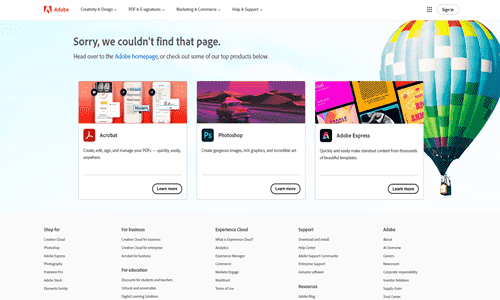
Description:
The OCR feature in Adobe Acrobat’s PDF editing suite allows users to turn scanned documents and photos into searchable and editable PDF files.
Pros:
Seamless integration with Adobe Acrobat, intuitive user interface, accurate text recognition, and support for multiple languages.
Cons:
Limited OCR capabilities, compared to dedicated OCR software, require an Adobe Acrobat subscription.
Mainly Used For:
PDF editing, document conversion, digital signatures, collaboration.
Pricing Package:
Adobe Acrobat offers subscription plans with varying features and pricing tiers, including options for individuals, businesses, and enterprises.
OmniPage Ultimate:
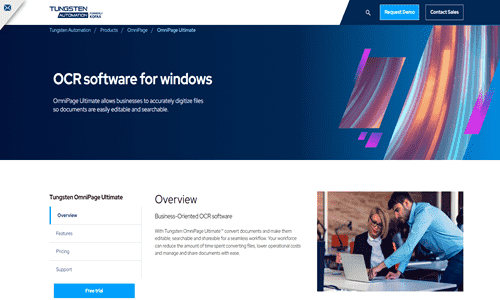
Description:
OmniPage Ultimate is a powerful OCR solution for converting documents into editable formats. It offers batch processing, document layout analysis, and automatic language detection features.
Pros:
Excellent accuracy in text recognition, support for large-scale document processing, integration with cloud storage services, and customizable workflow automation.
Cons:
A steep learning curve for advanced features may be resource-intensive for large documents.
Mainly Used For:
Document conversion, data extraction, automated document workflows, enterprise document management.
Pricing Package:
OmniPage Ultimate offers various licensing options, including perpetual licenses and subscription plans, with pricing based on the number of users and features required.
CaptureFast:
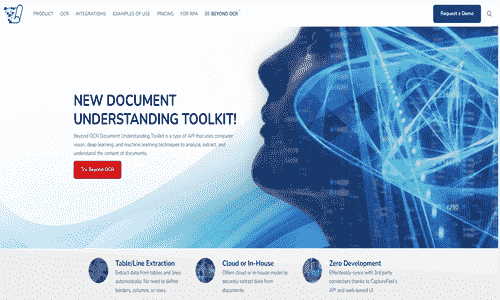
Description:
CaptureFast is a cloud-based document capture and OCR solution for businesses. It allows users to capture, extract, and organize data from documents using OCR technology and offers features such as customizable workflows and real-time collaboration.
Pros:
Cloud-based solutions are accessible from any device, have customizable workflows for document processing, and have real-time collaboration features.
Cons:
Compared to enterprise-level solutions, less advanced OCR features may require integration with existing systems for full functionality.
Mainly Used For:
Document capture, data extraction, invoice processing, workflow automation.
Pricing Package:
CaptureFast offers subscription plans with pricing based on the number of users and documents processed, with options for small businesses and enterprises.
Google Cloud Vision OCR:
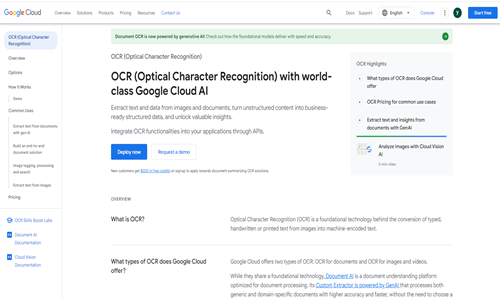
Description:
Google Cloud Vision offers OCR capabilities as part of its cloud-based vision API, providing developers access to advanced image analysis and text recognition technologies.
Pros:
Scalable and reliable cloud-based OCR solution, high accuracy in text recognition, support for multiple languages and file formats.
Cons:
Requires programming skills for integration and may have usage-based pricing.
Mainly Used For:
Image analysis, text extraction, automated data processing, integration with custom applications.
Pricing Package:
Google Cloud Vision OCR offers pay-as-you-go pricing based on usage, with free usage tier and volume discounts available for larger OCR requests.
Microsoft OneNote OCR:
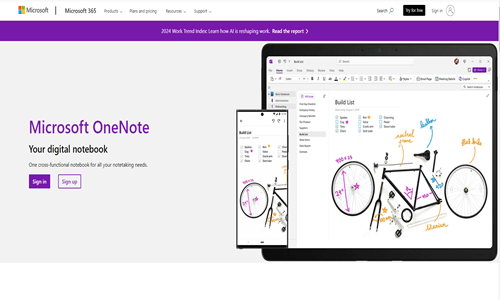
Description:
The OCR feature allows you to scan and search printed and handwritten text in Microsoft OneNote. The OneNote program lets users turn scanned documents and photos into searchable notes.
Pros:
Seamless integration with Microsoft Office suite, intuitive interface, and handwritten and printed text recognition support.
Cons:
Limited OCR capabilities compared to dedicated OCR software, primarily designed for note-taking and personal use.
Mainly Used For:
Note-taking, document annotation, personal organization, digital journaling.
Pricing Package:
Microsoft OneNote is available as part of Microsoft Office 365 subscription plans, with pricing options for individuals, businesses, and educational institutions.
OCR and Document Management Systems
OCR (Optical Character Recognition) technology plays a crucial role in document management systems (DMS) by enabling the conversion of scanned or image-based documents into searchable and editable digital formats. Here’s how OCR integrates with DMS:
Document Digitization:
OCR converts physical documents, such as paper records, invoices, and forms, into digital formats. This process makes documents electronically accessible within the DMS, eliminating the need for physical storage and enabling easy retrieval and sharing.
Text Extraction and Indexing:
OCR extracts text from scanned documents, including printed text and handwritten notes. The extracted text is then indexed and cataloged within the DMS, making it searchable by keywords or phrases. This indexing process enhances document organization and retrieval efficiency.
Enhanced Searchability:
OCR enhances the searchability of documents within the DMS by converting scanned images into searchable text. Using keyword searches, users can quickly locate specific information within documents, improving productivity and workflow efficiency.
Automation of Data Entry:
OCR automates data entry tasks by extracting relevant information from documents and populating metadata fields within the DMS. This automation reduces manual data entry errors, accelerates document processing, and improves data accuracy.
Document Classification and Routing:
OCR can analyze document content and automatically classify documents based on predefined criteria within the DMS. Based on their content, it can also route documents to the appropriate folders or workflows, enabling efficient document management and workflow automation.
Preservation of Document Formatting:
Advanced OCR solutions preserve documents’ original formatting and layout during conversion. This ensures that documents maintain visual integrity within the DMS, including fonts, styles, tables, and images.
Integration with Workflow Processes:
OCR seamlessly integrates with workflow processes within the DMS, enabling document routing, approvals, and collaboration. Automated workflows can be triggered based on OCR-extracted data, streamlining business processes and improving operational efficiency.
8. Compliance and Security:
OCR precisely captures and manages document content inside the DMS, ensuring compliance with regulatory standards. Additionally, it improves document security by allowing audit trails, access controls, and encryption for private data.
Future Trends in OCR Technology
Future trends in OCR (Optical Character Recognition) technology are expected to drive innovation and improve the capabilities of OCR solutions. Here are some emerging trends:
Artificial Intelligence and Machine Learning Integration
- Advanced Recognition Algorithms: Integrating AI and machine learning enables OCR systems to continuously improve accuracy and performance by learning from data.
- Adaptive Learning: AI-driven OCR systems can adapt to various fonts, languages, and document types, enhancing recognition capabilities over time.
- Contextual Understanding: AI-powered OCR can understand context and semantics, improving accuracy in complex documents and enhancing natural language processing capabilities.
Cloud-Based OCR Solutions
- Scalability: Cloud-based OCR solutions offer scalability, allowing organizations to process large documents efficiently.
- Accessibility: Cloud OCR services allow users to access OCR functionality from any internet-connected device, enabling remote collaboration and work.
- Cost-Effectiveness: Pay-per-use pricing models and reduced hardware requirements make cloud OCR solutions cost-effective for businesses of all sizes.
Mobile and Wearable OCR Applications
- On-the-Go Accessibility: Mobile OCR applications enable users to capture and process text using smartphones and tablets, making OCR technology more accessible and convenient.
- Real-Time Translation: Mobile OCR apps integrated with translation services can instantly translate text captured from signs, menus, and documents, improving accessibility for travelers and multilingual users.
- Wearable Devices: Incorporating OCR technology into wearable devices like smart glasses provides hands-free text recognition capabilities, boosting productivity across industries such as logistics, healthcare, and field service.
Handwriting Recognition and Natural Language Processing
- Improved Handwriting Recognition: Advancements in handwriting recognition algorithms enhance OCR’s ability to recognize handwritten text accurately, enabling the digitization of handwritten documents and notes.
- Natural Language Understanding: OCR systems integrated with natural language processing (NLP) capabilities can understand the context and meaning of text, enabling more intelligent processing and analysis of documents.
- Multimodal Input: The integration of OCR with voice recognition and image analysis technologies enables multimodal input, allowing users to interact with documents using speech, gestures, and handwriting.
Best Practices for OCR Software Usage
When using OCR (Optical Character Recognition) software, the following best practices can maximize its effectiveness and efficiency:
Optimize Document Quality
- Ensure that documents are scanned or captured in high resolution and with good lighting conditions to improve OCR accuracy.
- Remove any smudges, creases, or other imperfections from documents before scanning to minimize errors in text recognition.
Leverage OCR Templates and Zonal Recognition
- Create OCR templates for consistent document layouts to improve recognition accuracy and streamline processing.
- Utilize zonal recognition to specify areas of interest within documents, allowing for targeted text extraction and data capture.
Implement Quality Assurance Processes
- Establish quality assurance protocols to verify OCR results and identify errors or inaccuracies.
- Conduct periodic checks and validations to ensure that OCR output meets accuracy and reliability standards.
Integrate with Workflows and Automation
- Integrating OCR software with current workflows and automation systems will make document processing and data entry operations more efficient.
- Implement automated document classification, routing, and data extraction processes to improve efficiency and reduce manual labor.
Regularly Update And Maintain OCR Software
- Stay updated with the latest versions of OCR software to access new features, enhancements, and bug fixes.
- To ensure optimal performance, perform regular maintenance tasks, such as cleaning scanners, optimizing settings, and calibrating devices.
Frequently Asked Questions about OCR Software
What is the difference between OCR and ICR?
ICR specializes in recognizing and interpreting handwritten language, whereas Optical Character Recognition is typically utilized for identifying printed or typed text from scanned documents or photos.
How accurate is OCR software?
OCR software’s accuracy can vary based on several factors, including language complexity, font type, and document quality. In general, contemporary OCR software can recognize printed text with high accuracy rates—often above 95%.
Can OCR software handle handwritten text?
OCR software is adept at identifying printed text, and some advanced versions can recognize handwritten text with differing levels of precision. Conversely, ICR technology is fine-tuned for accurately interpreting handwritten characters.
Is OCR software compatible with different file formats?
Yes, OCR software typically supports a wide range of file formats for input (e.g., scanned images, PDFs) and output (e.g., searchable PDFs, editable text files). Commonly supported formats include PDF, JPEG, PNG, TIFF, DOC, and TXT.
How do I ensure data privacy and security when using OCR software?
The following steps should be taken into consideration while using OCR software to protect data security and privacy:
- Make use of trustworthy OCR software suppliers who place a high priority on data security and observing privacy laws.
- Use encryption techniques to protect data when it’s being transmitted and stored.
- To limit access to data that has been OCR-processed, use authentication procedures and access controls.
- Update OCR software frequently to fix security flaws and guarantee adherence to recommended security procedures.
- Provide staff with training on data handling policies and procedures to reduce the possibility of data breaches or illegal access.
Conclusion
OCR software has revolutionized textual information processing and interaction, allowing businesses to extract value from PDFs, pictures, and printed documents. Businesses may make well-informed decisions and deploy solutions that improve data accessibility, productivity, and workflow efficiency by knowing OCR software’s features, advantages, and limitations. The future of OCR offers even more accuracy, efficiency, and integration with cutting-edge technologies like artificial intelligence and machine learning as technology progresses. Adopting OCR software is a calculated risk that can propel digital transformation and help businesses maintain their competitiveness in a world where data drives more and more decisions.




